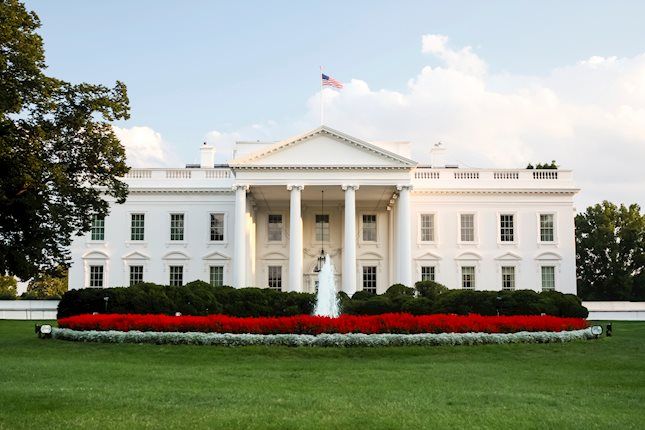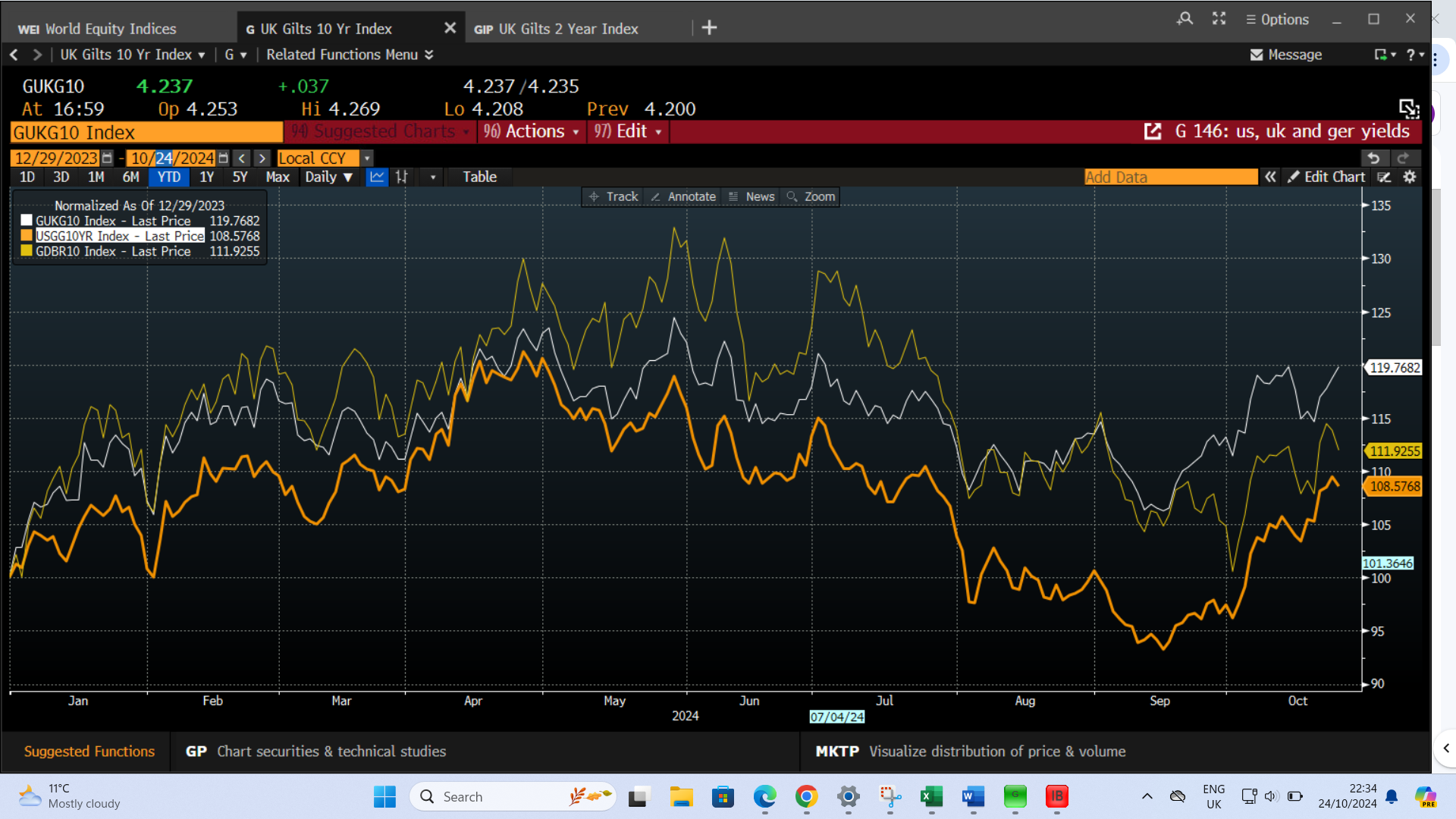Next week’s Budget was never just about tax and spend changes. It is more fundamental than that, and we now know that it will include a change to the way that the UK will measure public debt, which will free up to £50bn in extra fiscal headroom for the Chancellor. The news, which was first leaked to the press and then confirmed by the Chancellor, will deliver more fiscal headroom than expected by analysts and weighed on UK bonds. UK bond yields were the only sovereign yield to rise on Thursday, bucking the trend of weaker yields in Europe and the US. The 10-year UK Gilt yield was higher by 3.6 basis points, while the 2-year yield rose by 5 basis points.
This is hardly a ‘Truss-like’ market reaction, however, it adds to the upward pressure on the 10-year bond yield, which has already risen by more than 50 basis points in the past month. UK yields have also outpaced US and German yields in recent weeks, as you can see in the chart below, which has normalized US, UK and German 10-year bond yields to show how they move together.
US, German and UK 10-year bond yields
Source: XTB and Bloomberg
The investment rule
The Chancellor has justified this move to protect UK capital budgets. The Chancellor now has two fiscal rules: the first is to pay for day-to-day spending using revenues, which she calls her ‘stability rule.’ The second rule, the ‘investment rule’, will, according to the Chancellor ‘make space for the increased investment in the fabric of our economy’. These investments will be managed by new institutions including the National Infrastructure and Service Transformation Authority and the Office for Value for Money. They will be audited by the National Audit Office.
The Chancellor’s own op-ed piece did not specify the amount of money that would be freed up by changing the fiscal rules and there are some people who think that the Chancellor will spend less than the potential £50bn available. In theory, Reeves’s plan to change the second debt rule sounds positive. The Chancellor said that her ‘investment rule’ will get debt falling as a proportion of the economy, but she did not specify when this will happen nor by how much. Labour has said that its focus will be on growth. Investment is needed to boost growth, and Reeves sounds like she will scrutinize all projects to ensure that they will boost growth and the UK’s woeful productivity. However, the (early) proof in the pudding, will be the OBR’s growth forecasts. Will the OBR give a glowing review of Reeves’ plans and significantly upgrade GDP forecasts? The OBR’s March forecast for GDP for 2024 was 0.8%, this is likely to be upgraded since the economy has performed significantly better than that so far. Their forecast for 2025 was 2%, will this be upgraded along with future growth rates? The OBR will also give their assessment about future debt levels for the UK. If debt levels are not falling significantly on the back of tax hikes, trimmed spending in some areas and the change to the second fiscal rule, markets could be disappointed.
The high stakes budget
From a financial market perspective, this is a high stakes budget, and one that could have big ramifications for financial markets. The OBR and the Chancellor need to convince the markets that her debt rule change is best for the country and will reap growth benefits, otherwise UK bond markets could get spooked.
The market impact
As we lead up to the Budget, all three markets in the UK will be watched closely: bond markets, the pound, and stocks. FX traders will be looking to see if Reeves can push GBP/USD significantly back above $1.30, and equity traders will be watching for any changes that could impact sentiment towards UK companies. Banks could be at risk, and changes to employer contributions to National Insurance are also on the cards next week. As you can see in the chart below, the FTSE 100 has performed in the lower half of major US and European indices this year. Partly this is down to global trends, and more recently this could be due to a slowdown in economic data in the UK, in part caused by economic uncertainty created by the Budget.
FTSE 100, S&P 500, Eurostoxx 50, Dax and Cac 40. They have been normalized to show how they move together YTD
Source: XTB and Bloomberg
Mixed signals for UK growth
As we lead up to this budget, there is a mixed economic backdrop for the UK. The IMF has upgraded the UK’s growth forecast for this year and next. It now expects 2024 growth to register 1.1%, a 0.4% increase, while growth in 2025 is expected to be 1.5%. Although this is behind the rate for Canada and the US, it is the strongest rate of growth in Europe. However, the bad news was the third highest ever rate of borrowing for the UK for September on record. Borrowing topped £16.6bn, lower than economists expected, but still more than £2bn higher than the September borrowing rate in 2023.
UK fiscal picture deteriorates
Mid-way through the fiscal year, and the UK has already overshot the Office for Budget Responsibility’s borrowing forecast by £7bn. This should have drastically reduced the Chancellor’s fiscal headroom. However, she has been able to employ some fiscal trickery this Halloween eve, to boost the amount of money available to invest in public services and infrastructure.
Tax changes already flagged
The UK needs to live within its means, just like the rest of us. The Chancellor claims to have a £22bn black hole that she needs to remedy. The Chancellor has not been shy in talking up the prospect of tax increases in this budget. Reeves has pledged not to raise income, corporation tax, or VAT, so she will need to tinker with more complicated taxes to boost the fiscal coffers. The tax rises that are most likely at this budget include an increase to Capital Gains Tax (CGT). The Prime Minister said that reports CGT could rise to 38% were ‘wide of the mark’. Inheritance tax is also in line for an increase, including removing tax relief for smaller companies listed on the UK junior market. Pensions could also be subject to inheritance tax, and the Chancellor may extend the time period needed to make gifts inheritance tax free.
There have also been well-flagged plans to increase national insurance contributions for employers, and to impose national insurance contributions on employer pension contributions.
Detailed spending plans to wait for 2025
Spending plans are less clear. There have been reports that there could be money allocated to build more council houses, although that has not been verified by the Treasury. Regarding the NHS, the Prime Minister has said that there will be no more money without reform. However, we may not get too much detail about reform plans for the NHS in this Budget, as the Health Secretary will present a 10-year plan for the NHS next spring.
Investors act ahead of budget
Budgets can have a big physical impact on financial markets. The Chancellor’s plans for tax increases have already led to behavior change. There was a 16.3% surge in CGT tax receipts last month ahead of next week’s budget. Tax rises could come into force at the start of the next fiscal year, on 6th April, thus we could see a surge in CGT receipts in the next 5 months.
An easier option to raise tax would be a small increase to income tax or VAT, she has already ruled out changing corporation tax. However, after clarifying that she thinks people who earn over £100,000 are still working people, it seems unlikely that she will adjust income tax in this budget.
Bank reserves could be targeted
Other revenue- generating measures that Reeves is thought to be looking at ahead of this Budget, is to target banks, who have been earnings vast sums of interest on deposits held at the Bank of England. A ‘Tiering system’ could limit the amount of interest earned by UK banks based on their size. The UK’s largest banks earned more than £9.2bn from interest on their reserves last year. A tiering system could protect smaller banks who rely on the interest payments as a source of income, while targeting the largest banks with the broadest shoulders. Reeves may also target the Bank of England, she could urge the bank not to sell their bond holdings at a loss, as they embark on quantitative tightening. Instead, she could ask them to hold onto their bonds until they mature, without any financial impact on the Treasury. However, if she chooses to do this, it could damage the BOE’s reputation as an independent central bank.
The market impact:
The backdrop to this Budget is one of a weakening pound and rising bond yields. Over the past month, GBP/USD has fallen more than 3%, as the dollar has dominated the G10 FX space. This move lower in GBP/USD, is mostly down to dollar strength rather than weakness in sterling, which has performed in the middle of the G10 FX pack for the past month.
Likewise, UK Gilt yields are also moving in unison with global trends. The 10-year yield is higher by 51 basis points in the past month. The 2-year UK Gilt yield is higher by 38 bps. This is lower than the rise in US Treasury yields, the 10-year Treasury yield is higher by 64 bps in the past month, while the 2-year Treasury yield is higher by 58bps. There has been a global trend for higher sovereign bond yields, however, the anticipation of the budget appears to have added upward pressure to Gilt yields in recent days.
As mentioned above, a backdrop of rising bond yields means that the Chancellor needs to be careful not to spook financial markets in this Halloween eve Budget. She may also hope that once the uncertainty of the budget is out of the way, it could lead to a treat of stronger UK growth as we move towards the end of the year.
CFD’s, Options and Forex are leveraged products which can result in losses that exceed your initial deposit. These products may not be suitable for all investors and you should seek independent advice if necessary.
Recommended Content
Editors’ Picks

EUR/USD holds steady above 1.0800, looks to post weekly losses
EUR/USD trades marginally higher on the day above 1.0800 after the data from the US showed that Durable Goods Orders declined by 0.8% in September. Nevertheless, the pair remains on track to close the fourth consecutive week in negative territory.

GBP/USD extends recovery to 1.3000 area
GBP/USD extends its recovery and trades at around 1.3000 in the American session on Friday. The US Dollar struggles to gather strength as the market mood remains positive heading into the weekend, allowing the pair to hold its ground.

Gold fluctuates in narrow range below $2,750
Gold stays in a consolidation phase and fluctuates in a relatively tight range below $2,750 on Friday. US Treasury bond yields stabilize in the American session, making it difficult for XAU/USD to gather directional momentum.

Crypto Today: XRP, Bitcoin and Ethereum decline as Ripple files response to SEC appeal
XRP loses over 1.30% as Ripple's executive confirms the filing of an important document in the appeals process in the SEC lawsuit. Bitcoin corrects less than 1% and sustains above $67,500. Ethereum is down nearly 0.20%, holding above the key support level of $2,500.

US elections: The race to the White House tightens
Trump closes in on Harris’s lead in the polls. Neck and neck race spurs market jitters. Outcome still hinges on battleground states.

Best Forex Brokers with Low Spreads
VERIFIED Low spreads are crucial for reducing trading costs. Explore top Forex brokers offering competitive spreads and high leverage. Compare options for EUR/USD, GBP/USD, USD/JPY, and Gold.

